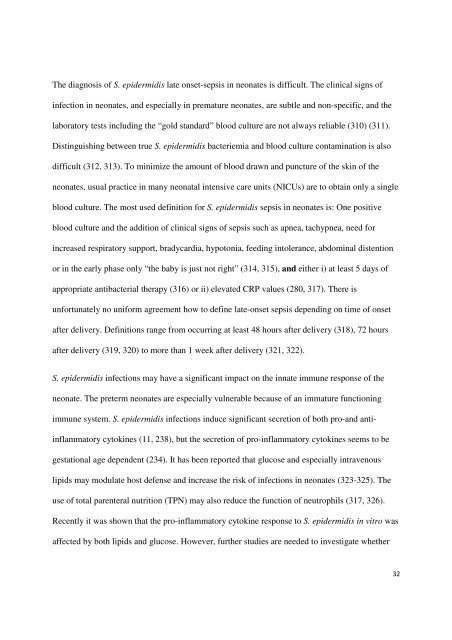Staphylococcus epidermidis - virulence factors and innate ... - Munin
Staphylococcus epidermidis - virulence factors and innate ... - Munin
Staphylococcus epidermidis - virulence factors and innate ... - Munin
You also want an ePaper? Increase the reach of your titles
YUMPU automatically turns print PDFs into web optimized ePapers that Google loves.
The diagnosis of S. <strong>epidermidis</strong> late onset-sepsis in neonates is difficult. The clinical signs of<br />
infection in neonates, <strong>and</strong> especially in premature neonates, are subtle <strong>and</strong> non-specific, <strong>and</strong> the<br />
laboratory tests including the “gold st<strong>and</strong>ard” blood culture are not always reliable (310) (311).<br />
Distinguishing between true S. <strong>epidermidis</strong> bacteriemia <strong>and</strong> blood culture contamination is also<br />
difficult (312, 313). To minimize the amount of blood drawn <strong>and</strong> puncture of the skin of the<br />
neonates, usual practice in many neonatal intensive care units (NICUs) are to obtain only a single<br />
blood culture. The most used definition for S. <strong>epidermidis</strong> sepsis in neonates is: One positive<br />
blood culture <strong>and</strong> the addition of clinical signs of sepsis such as apnea, tachypnea, need for<br />
increased respiratory support, bradycardia, hypotonia, feeding intolerance, abdominal distention<br />
or in the early phase only “the baby is just not right” (314, 315), <strong>and</strong> either i) at least 5 days of<br />
appropriate antibacterial therapy (316) or ii) elevated CRP values (280, 317). There is<br />
unfortunately no uniform agreement how to define late-onset sepsis depending on time of onset<br />
after delivery. Definitions range from occurring at least 48 hours after delivery (318), 72 hours<br />
after delivery (319, 320) to more than 1 week after delivery (321, 322).<br />
S. <strong>epidermidis</strong> infections may have a significant impact on the <strong>innate</strong> immune response of the<br />
neonate. The preterm neonates are especially vulnerable because of an immature functioning<br />
immune system. S. <strong>epidermidis</strong> infections induce significant secretion of both pro-<strong>and</strong> antiinflammatory<br />
cytokines (11, 238), but the secretion of pro-inflammatory cytokines seems to be<br />
gestational age dependent (234). It has been reported that glucose <strong>and</strong> especially intravenous<br />
lipids may modulate host defense <strong>and</strong> increase the risk of infections in neonates (323-325). The<br />
use of total parenteral nutrition (TPN) may also reduce the function of neutrophils (317, 326).<br />
Recently it was shown that the pro-inflammatory cytokine response to S. <strong>epidermidis</strong> in vitro was<br />
affected by both lipids <strong>and</strong> glucose. However, further studies are needed to investigate whether<br />
32
















